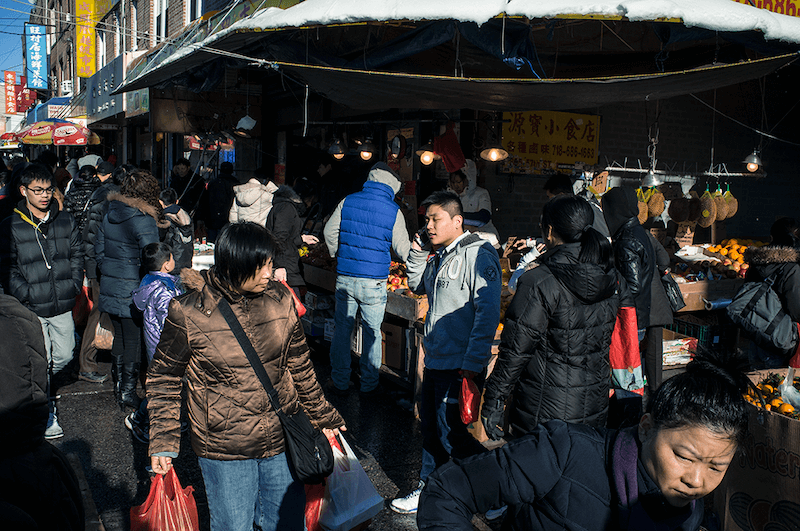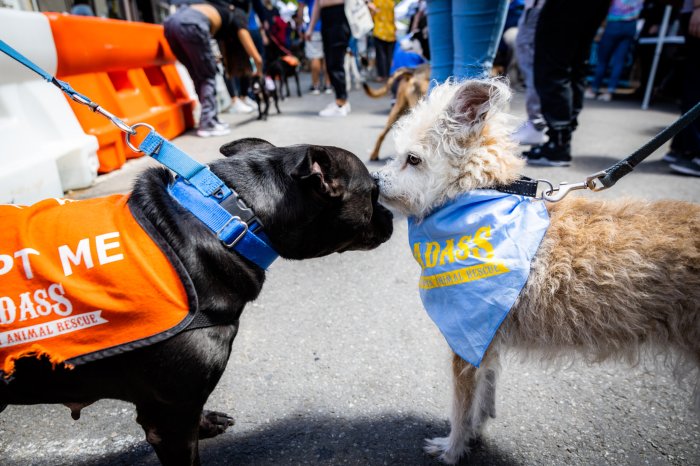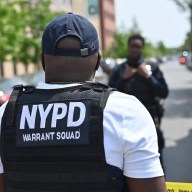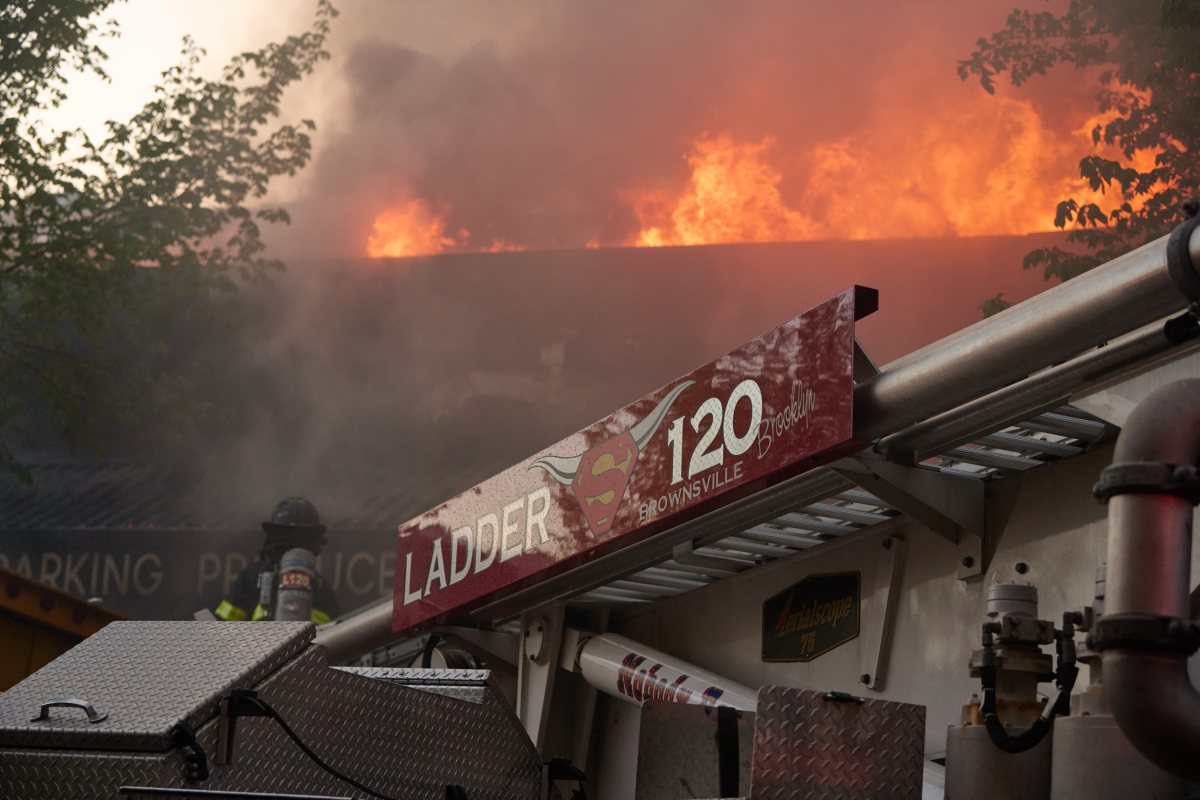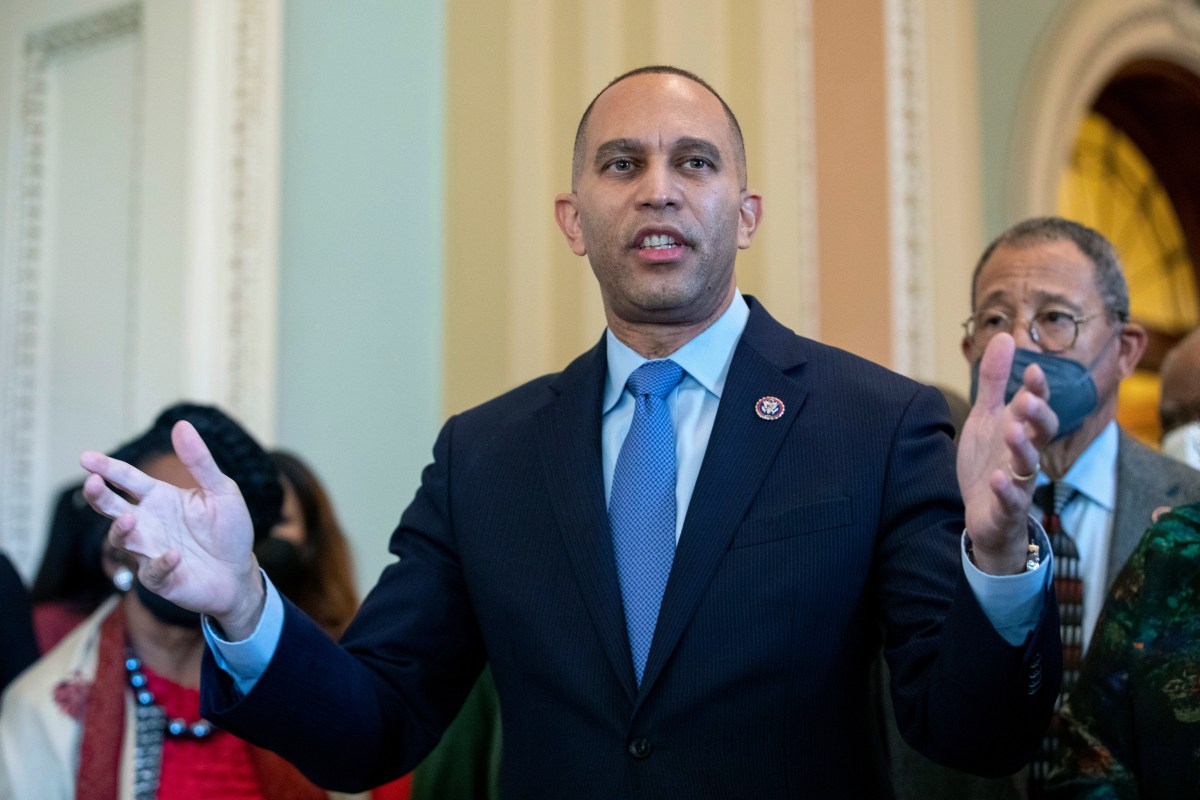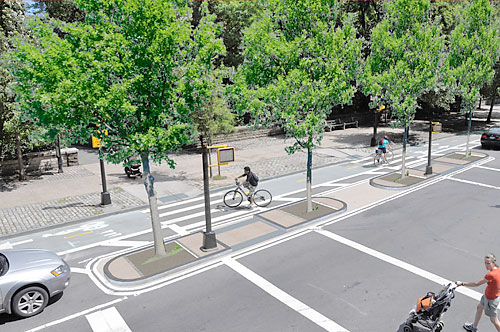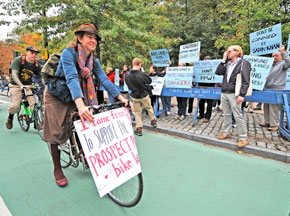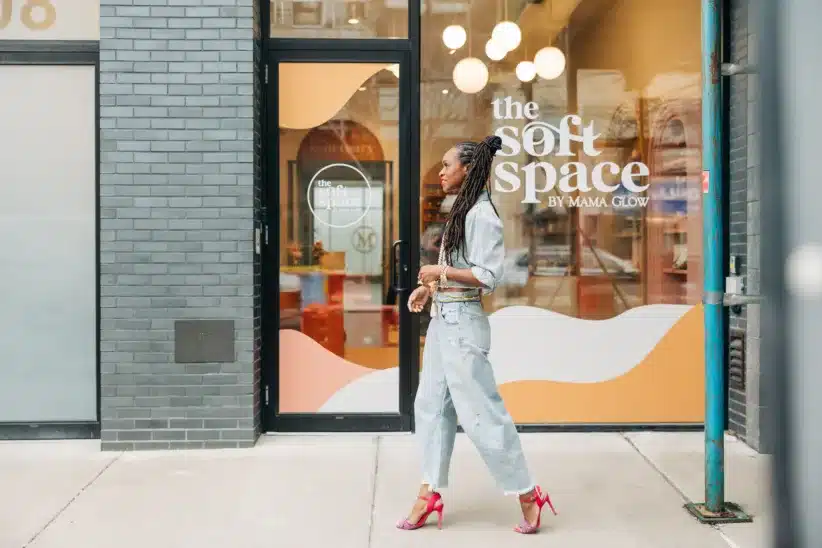Southern Brooklyn cyclists largely support a plan to convert Seventh and Eighth avenues into one-way streets, making way for protected bike lanes on both roadways — despite one local lawmaker’s claims at a recent community board meeting.
“It’s not going to surprise you to know I am in favor of the plan despite what you may have heard,” said Brian Hedden, president of Bike South Brooklyn, a bicycle safety advocacy group focused on the southern half of the borough.
The city Department of Transportation has proposed turning stretches of both Seventh and Eighth avenues into one-way streets, with Seventh Avenue running south and Eighth Avenue running north between 39th and 65th Street. The plan, which also includes the creation of protected bike lanes on both avenues, and an expansion of the sidewalk on a stretch of Eighth Avenue from 51st to 60th streets, spans community boards 7, 10 and 12.
At a Sept. 9 meeting of Community Board 10 at Park Asia Restaurant, Assemblymember Peter Abbate — who has publicly opposed the plan, citing its potential impacts on commerce in Brooklyn’s Chinatown, a loss of parking and the relocation of the southbound B70 bus — told board members that no one was in support of the project, including Hedden.
“We are trying to find out who is for it,” Abbate said. “Also, the bicycle groups — Brian Hedden for the South Brooklyn cyclists — they are not for the plan … tell me who is for the plan in the community.”
Abbate’s concerns were echoed at the meeting, and his claims about local cyclists went uncontested — something Hedden told Brooklyn Paper was due to a directive from Bike South Brooklyn’s leadership to send their feedback directly to DOT instead of fighting for their voices to be heard at three separate community bard meetings.
“[Our five co-founders decided not to] put our supporters through three separate community board meetings that are geared towards people yelling at them when it won’t sway the boards anyway,” Hedden said. “We’re going to ask them to contact the DOT directly, and if they live in [Councilmember Carlos] Menchaca’s district, to also reach out to him. We have in the past asked people to go to these meetings — not doing it this time was a choice based on the split jurisdiction.”
Hedden said that though Abbate has tried to reach him by telephone on multiple occasions, he has chosen not to engage with the elected official because of their differing priorities.
“He called me twice and left voicemails,” Hedden said. “I didn’t get back to him because he’s established himself as the leading opponent of road safety in Southern Brooklyn, why would I?”
Speaking with Brooklyn Paper after the meeting, Abbate again maintained that he is not against bike lanes in the district — but that he thinks there are better locations for them.
“I am not against bike lanes, maybe we could have them on Sixth or Seventh avenues,” said Abbate. “I reached out to [Hedden] and said, ‘Let’s look at it that way…” and then he never got back to me so I assumed he was okay with it.”
Abbate further claims that Hedden and his group should agree with his assessment of the project, which he believes will cause chaos along the thoroughfares, and not be safe for anyone — including cyclists.
“I thought he was with me and he should be,” the pol said. “I mean if he wants a safe bike lane, I think a safe bike lane is on a different avenue.”
In search of ‘something different’
The head of the Brooklyn Chinese-American Association previously told Brooklyn Paper the project impacts parking in the busiest section of Chinatown.
“We really rely on people who used to live in Sunset Park and moved to Bay Ridge, Bensonhurst and other areas,” Paul Mak said. “By not being able to find parking spots, by having a 10-times worse congestion on Seventh and Eighth avenues, people will just stay away from Brooklyn’s Chinatown.”
To connect the one-way streets for bicyclists and vehicles, traffic planners proposed a new left-turn bay for 65th Street to accommodate the rerouting of northbound traffic to Eighth Avenue, as well as a contraflow protected bike lane taking bicyclists east from Seventh to Eighth avenue on 66th Street. Another element of the project is to transition to angled parking on 67th Street between Seventh and Ninth avenues next to Leif Ericson Park.
Attendees of the meeting were disappointed that the transportation honchos returned to the community without any changes to their plan, despite the agency’s previous claims they had heard feedback from the community.
“They already heard this six times,” said Irene Chu, chief of staff for Abbate, when translating for members of the audience. “They really want something different.”
However, transportation representatives said their previous settlement of the Article 78 lawsuit filed by members of three community boards mandates they present the project before each community board — but Abbate, as well as Community Board 10’s district manager, said the terms of the agreement did not require them to present the exact same plan from back in June.
“We have been mandated that we have to come and present to the transportation committee of CB10, we have to present in the same presentation that we made prior,” said Leroy Branch, community liaison for the Department of Transportation.
“You didn’t have to do the same thing, you could have come here with a different plan,” Abbate retorted. “We didn’t say you had to come with the original plan.”
The community also bashed the agency for not providing a translator when much of the area speak Mandarin — with one audience member exclaiming the department did not want them to understand the plan — leaving Abbate’s chief of staff to translate public comment and agency responses for attendees.
While the project is mostly in the jurisdiction of Sunset Park’s Community Board 7, there are some major changes within Bay Ridge’s Community Board 10 that raise alarm to their members — especially the proposal’s creation of a dead end at 65th Street and Seventh Avenue, Beckmann said.
“Creating a deadhead at 65th Street and Seventh Avenue horrifies many members of the committee that have spoken before,” said Josephine Beckmann, district manager of Community Board 10. “We have done extensive work to improve safety at that intersection.”
A representative from DOT said Community Board 7 asked the agency in both 2003 and 2015 to study a potential one-way conversion of Seventh and Eighth avenues and the transportation department denied the request on both occasions.
“The history is Community Board 7 in 2003 asked us to study a one-way conversion of Seventh and Eighth avenues at the time we looked into it, we said no, they asked us again in 2015 I believe, we again looked at it and then said no again,” said Ben Schwed, city transportation’s lead project manager for the one-way conversion proposal.
However, they are now taking up the project because data shows that Eighth Avenue is one of Brooklyn’s most dangerous streets for pedestrians with some of the highest rates of pedestrians fatalities and severe injuries across the borough. Seventh Avenue shows similar crash data, Schwed said.
“What changed after then, there are two things that changed,” Schwed said. “One, Eighth Avenue became a Vision Zero priority corridor and two, we developed tools we did not have in our toolbox at the time.”
But Beckmann said that is not exactly what she heard from Community Board 7 and it seems there is some confusion on the agency’s part in understanding what the panel asked for.
“I think that question really should be answered by CB7,” Beckmann said. “I don’t want to speak for them because there is some confusion between what they asked for and what they requested so I just want to clarify that since my colleagues aren’t here.”
She further added that Community Board 10 had records from the Department of Transportation stating both of those years that the conversion wasn’t possible because of numerous safety concerns that are still pertinent today — and in previous years the conversion went to 60th Street and therefore was not within CB10’s district.
“I can tell you that recorded in writing we have responses both from DOT in both of those years and both times it was not feasible,” Beckmann said. “There were reasons that were listed and numerated why it was unsafe and many of those concerns we have today that were raised.”
A need to calm the ‘chaos’
A Sunset Park native and head of a female-identifying cyclist group said she’s overall in support of the city’s proposal as it is an opportunity to calm traffic on that corridor and make it safe for all its users — not just cyclists.
“I think we need to think about it as prioritizing people first,” said Angela Azzolino, the executive director of Get Women Cycling. “The reason why this is happening is not to give people who ride bikes the safer path, it’s to give people a safer path. It’s part of the Vision Zero project, not a bicycle unit project.”
She said the Department of Transportation, as well as the area’s elected officials, need to provide better outreach to residents in regards to education on and alerting the public to the project, claiming that, even though she’s very involved locally, she had no idea of the plan.
“I think the city historically has had an issue with reaching and hearing communities,” she said, “and I partner with the city and I’m very active in the space and I didn’t know about it.”
Though, Azzolino said she knows now that transportation honchos are putting in an effort to keep the community apprised on the project. She added that these types of projects shouldn’t be framed as cyclists versus drivers as they often are, but instead as a plan to make the streets safer for everyone.
“We got to take the labels and look at the people in these communities, and everywhere in New York,” Azzolino said, “the majority of folks travel outside of cars and they are getting hurt the most.”
Another co-founder of Bike South Brooklyn said something needs to change, because neither of the thoroughfares in question are working as they are currently configured.
“It doesn’t really matter if you are walking, if you are running, if you are riding a bike, if you are driving a car, or taking a bus,” said John Tomac. “Both of those avenues are just absolutely chaotic.”
He said that while most of last week’s attendees of the CB10 meeting were not bicycle advocates, there was a common consensus that these two corridors were a problem.
“I think a lot of people who came up there and said they were opposed to the plan, also were not shy about identifying the fact that traffic there is a problem, it’s an unsafe mess, that the status quo isn’t quite working,” he said.
The longtime bicycle safety advocate made an argument against people’s concerns about safety for seniors having to cross more intersections due to the relocation of the southbound B70 bus to Seventh Avenue and the consolidation to fewer stops — as the plan’s traffic calming measures would make it safer to cross the street.
“Ideally, you have a plan here where you’re calming down traffic so crossing the street is not as a big of a deal, it’s not as dangerous and its not as long,” Tomac said.
He said this project also fits in with recent bicycle projects in Bay Ridge and Sunset Park, therefore creating a better network for southern Brooklyn cyclists as it will connect to a protect bicycle lane from 66th Street to 79th Street in Bay Ridge, while also creating a safer area to cycle around Leif Ericson Park, which has recently seen the addition of Citi Bikes.
A recent survey from the New York City Economic Development Corporation shows that less than 40 percent of households in Sunset Park own a car, which is the least in the borough along with Downtown Brooklyn and northwesterly nabes.


